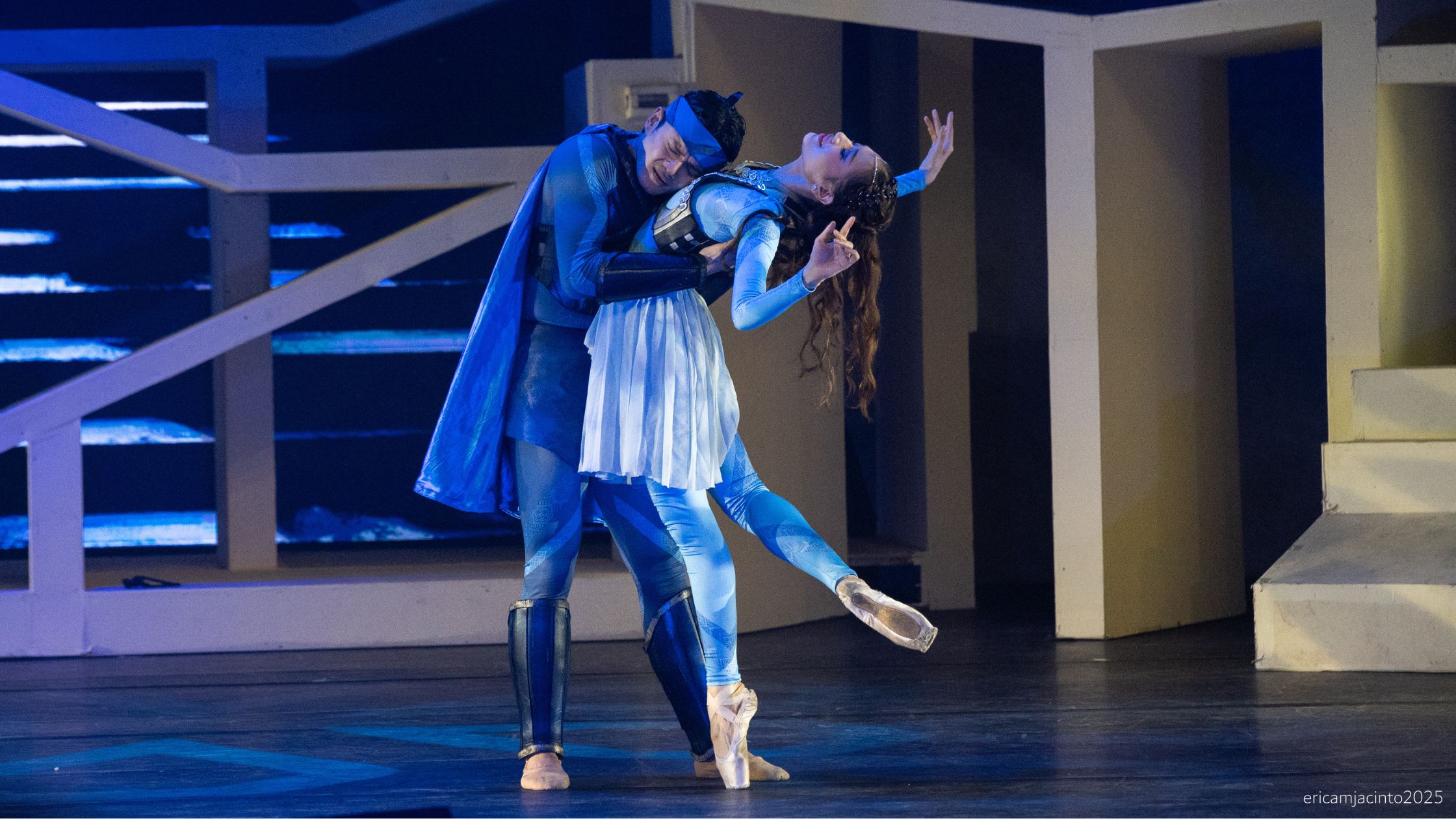
REVIEW: BM’s ‘Florante at Laura’ Dances Between Epic and Excess
My view of Ballet Manila’s Florante at Laura is like a love affair. At first, there is the heady attraction when everything feels perfect. But as time passes, you begin to see the cracks.
When it premiered last year, the production dazzled with the lush, old-Hollywood sweep of National Artist Ryan Cayabyab’s score, the rich playing of the Orchestra of the Filipino Youth, and Ballet Manila’s vibrant, full-bodied dancing. It was the kind of work that swept you off your feet with its emotion and theatrical scale.
This year’s Florante at Laura still carried that power. From the principals to the corps, the dancers moved as if giving twice their strength, and you could feel they were completely lost in the music. Joshua Enciso as Florante and Abigail Oliveiro as Princess Laura brought deeper shading and emotional clarity to their roles, their duets charged with both devotion and restraint. Noah Esplana and Stephanie Santiago, as Aladin and Flerida, danced with conviction and grace, their chemistry quietly luminous. Mark Sumaylo’s Sultan Ali Adab and Romeo Peralta’s Conde Adolfo conveyed authority and menace without excess, while Elmo Dictado as Menandro and John Balagot as General Osmalik stood out for their buoyant jumps and sharp turns despite their limited stage time.
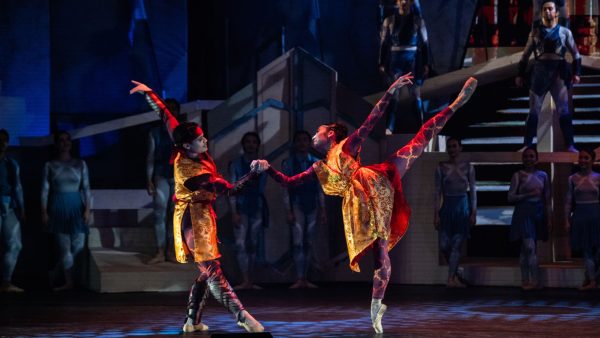
Noah Esplana as Aladin, Stephanie Santiago as Flerida; Photo Credit: Erica Feliz Marquez-Jacinto
The Orchestra of the Filipino Youth, now composed of a new batch of musicians, carried Cayabyab’s sweeping score with intensity. Their sound was as polished as last year’s batch.
Still, something felt different this time. The energy was there, but the magic seemed to waver. Florante at Laura is a demanding work—dense in structure, performed on a challenging set whose lighting and costumes sometimes made the stage feel crowded.
Choreographers Gerard Francisco and Martin Lawrance worked closely with scholar Michael Coroza in highlighting the salient aspects of Francisco Balagtas’ epic poem. The dance played out like textbook episodes to make it easy for the audience to understand.
SUBVERSIVE FORCES
The ballet opens in a forest, where Florante stands bound to a tree, helpless before the lions circling him. From this scene of peril, the story unfolds in flashback—the battle of Crotona and the tangled fates that brought him to this moment.
In the kingdom of Albania lived Florante, a nobleman educated in Athens under the wise Antenor. There he met Conde Adolfo, a fellow student whose envy deepened with each of Florante’s triumphs. When Adolfo’s jealousy turned violent, Florante was saved by his loyal friend Menandro. Returning to Albania, Florante became a trusted warrior of King Linceo and fell in love with the king’s daughter, Laura.
War soon broke out when Persia invaded Albania. Florante led his army with courage, defeating the Persian soldiers, including Prince Aladin—whom he spared in a moment of compassion.
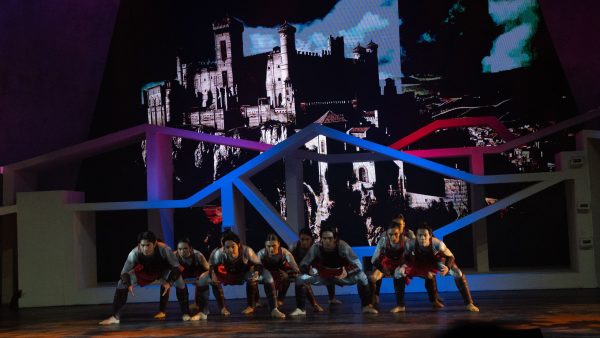
Persian army; Photo Credit: Erica Feliz Marquez-Jacinto
But while Florante was at war, Adolfo seized the throne. He murdered King Linceo and Duke Briseo, Florante’s father, and took Laura captive. When Florante returned home, Adolfo ambushed him, bound him to a tree, and left him to die.
Meanwhile, in Persia, Aladin faced betrayal of his own. His father, Sultan Ali Adab, driven by jealousy and lust for Aladin’s beloved Flerida, ordered his son’s death. Aladin escaped and wandered into the same forest where Florante lay imprisoned. Remembering the mercy once shown to him, he freed Florante, and the two men—former enemies—found kinship in their shared suffering.
Flerida soon appeared, fleeing the Sultan’s tyranny. She came upon Adolfo attempting to harm Laura and, with her bow, struck him down. Peace returned to Albania. Florante and Laura were reunited, while Aladin and Flerida departed together, their own ordeal finally over.
Ballet Manila’s staging of Florante at Laura feels timely, its story echoing the cycles of betrayal and power that shadow our political life. In Adolfo’s lust for control and his private army, we glimpse a familiar pattern in our politics—subversive forces that rise from within, seeking to seize power for their own ends.
STRONG SEQUENCES
The material’s complexity and length can be daunting to choreograph. Florante’s flashback began with Albanian soldiers preparing for war against the Persians attacking Crotona, the homeland of Florante’s mother.
The fight was sparked by the Persian invasion of Crotona, a coastal city dear to Florante because of his mother’s roots there. The conflict raised the stakes from a national defense to a personal crusade, testing the loyalty of the Albanians and the resolve of their young leader. On stage, it became both a battle and a portrait of heroism under fire.
It was one of the evening’s strongest sequences. Three soldiers entered one by one through an opening, their movements using shifting levels to build tension and display power—squats, floor rolls, sharp thrusts, contractions and secure multiple pirouettes with raised arms. More dancers joined to form the Albanian army, with men lifting their partners high to suggest strength and dominance. The music swelled as Menandro, danced by Elmo Dictado, launched into an agile solo of jumps and turns before Florante appeared at the top of the platform to assert his command.
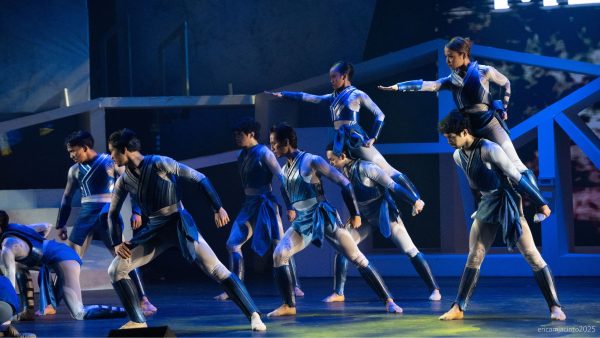
Albanian army; Photo Credit: Erica Feliz Marquez-Jacinto
The battle of Crotona that followed, led by General Osmalik, remained visually engaging. Persian strains in the music framed the choreography, with the Persian army dancing atop the platform like warriors on high ground before sliding down the ramps to advance. The opposing sides clashed in shifting formations that mirrored the changing tides of war—one soldier standing while another lay on the ground to mark victory and defeat. The scene closed with a powerful tableau of the Albanian army pointing toward the fallen Osmalik.
Before the Persian-Albanian war, a quiet palace scene offered one of the ballet’s most lyrical moments: the pas de deux between Florante and Laura. She tied a bandana around his head, a simple gesture that became a symbol of devotion. Their duet was filled with spiraling movements—she circled her leg around him, he caught and lifted her, then lowered her into a sweeping turn that carried both tenderness and urgency. Enciso and Oliveiro captured the ache of impending separation, their movements tracing the fine line between duty and love.
BUSY PRODUCTION
As the ballet moved forward, the momentum began to wane. For those less familiar with dance or the poem, the group scenes in the court and the battlefield began to blur together, their choreography marked by similar gestures and formations. Arm gestures became repetitive—flourishes for the women, grand leaps and barrel turns for the men. The ensemble dances turned linear, losing the sculptural depth of the earlier sequences. The choreography demanded a supple torso and grounded movement; a touch more training in contemporary dance would have helped the corps bring those twisting, spiraling passages fully to life.
The ballet regained its spark in Act 2, when Sultan Ali Adab and Aladin vied for Flerida. In one striking pas de deux, the Sultan’s attempt to dominate Flerida brandished Sumaylo’s strength as a partner, especially when he held Santiago aloft in a one-arm overhead lift and circled the stage, displaying both control and possession.
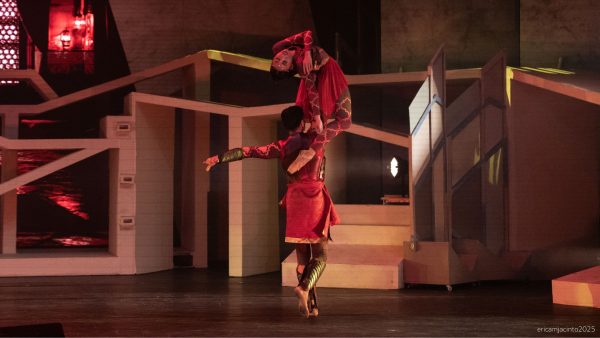
Mark Sumaylo as Sultan Ali Adab, Stephanie Santiago as Flerida; Photo Credit: Erica Feliz Marquez-Jacinto
Most of the leads were drawn in broad strokes. Florante and Aladin were the virtuous heroes meant to earn sympathy, while Sultan Ali Adab and Conde Adolfo carried the burden of villainy. Laura, danced with her characteristic lyricism by Oliveiro, traced a small but clear arc—from the sheltered daughter of King Linceo to the devoted lover defying Adolfo’s advances. Flerida, rendered with contained strength by Santiago, served as Laura’s foil, a figure of loyalty and courage standing firm against the Sultan’s power.
The production design by Mio Infante did little to clarify the story. The irregularly-shaped platform, with its ramps and cutouts for entrances, seemed meant to suggest the tangled structure of Balagtas’ epic. In practice, it often competed with the LED projections behind it, which shifted from forests to palaces to dungeons. The set’s structural openings were sparingly used, and John Batalla’s color-coded lighting and changing floor patterns only added visual noise. Batalla’s lighting, effective in concert settings, struggled here. Scenes meant to be serious were brightly lit, while the most uplifting moments of Cayabyab’s music played out in dullness.
The costumes by Therese Arroyo were equally uneven. The color codes—blue for the Albanians, green for Adolfo’s rebels, red for the Persians—made the dancers look bulky and oddly uniform, like varsity teams in cosplay. More puzzling were the court dancers in Sultan Ali Adab’s scenes, who performed bare-armed and midriff-baring choreography. In a story rooted in Muslim culture, this choice felt culturally off-key: Muslim women must be fully covered for modesty. If the design drew from Middle Eastern dance traditions, it lacked context, especially since the choreography contained no such movement.
Still, Ballet Manila deserves credit for daring to bring Florante at Laura to life through dance. The company’s ambition alone nudges audiences to revisit Balagtas’ text, perhaps even to pick up a graphic or annotated edition for context. As one of my companions said while leaving the theater, “Can you imagine reading this in high school, with all that adult content –a father lusting for his son’s girlfriend, and never realizing how intense it really was?”
Tickets: P2,575 (Center) and P1,545 (Sides)
Show Dates: October 3 at 8 PM, and October 4 and 5 at 5 PM
Venue: Aliw Theater
Running Time: 2.5 hours (with one 15-minute intermission)
Creatives: Lisa Macuja Elizalde (artistic director), Gerardo Francisco Jr. and Martin Lawrance (co-choreographers), Ryan Cayabyab (composer), Dr. Michael Coroza (librettist), Mio Infante (set designer), Therese Arroyo (costume designer), John Batalla (lighting designer)
Featured Cast:
Oct 3 and 5: Joshua Enciso (Florante), Abigail Oliveiro (Laura), Romeo Peralta (Adolfo), Noah Esplana (Aladin), Stephanie Santiago (Flerida), Mark Sumaylo (Sultan Ali Adab)
Oct 4: Rafael Perez (Florante), Shamira Drapete (Laura), Romeo Peralta (Adolfo), Noah Esplana (Aladin), Jessica Pearl Dames (Flerida), John Ralp Balagot (Sultan Ali Adab)


Comments